Saturday, February 29, 2020
Tips for Painting Realistically in Gouache and Watercolor
In this new Youtube video I sketch of a pile of snow along a country road using gouache and watercolor.
I start in watercolor, applying the paint wet with big brushes, and gradually shifting to a more opaque approach. I use drybrush effects to capture the texture of the gravel road. The gouache goes on thickly for the highlights and accents.
Gouache and watercolor squeezed out from the tube can be used in combination for any kind of plein-air painting or urban sketching.
WATERCOLORS
Ultramarine blue
Raw sienna
Cadmium yellow
Perylene maroon
GOUACHE
Titanium white
Ivory black
Set of gouache primary colors
Labels:
Gouache,
Plein Air Painting,
Watercolor Painting
Friday, February 28, 2020
Vertebral Drawbridge
The vertebral drawbridge is a one-way passage into the Rainy Basin, Dinotopia's dangerous realm of the carnosaurs. The weight of a sauropod caravan flexes the structure downward, allowing armored convoys to cross over, before the bridge springs back up again.

The fun of biomorphic or zoomorphic engineering is that you arrive at natural forms not because they're beautiful in some detached aesthetic sense, but because they're purely efficient and functional, as are all forms in nature.
My dad, grandfather, great-grandfather, and my great uncles were all mechanical engineers, and they always rhapsodized about how skeletons are fascinating structures from a design perspective, combining strength, flexibility, lightness, and adaptability.
-----
Labels:
Dinotopia
Thursday, February 27, 2020
Monet Contemplates Eye Surgery
French impressionist Claude Monet (1840-1926) began to notice that something was changing in his vision.
According to a British medical journal, he said that "‘colours no longer had the same intensity for me’, that ‘reds had begun to look muddy’ and that ‘my painting was getting more and more darkened.’
"To avoid choosing the wrong colors, Monet started to label his tubes of paint and keep a strict order on his palette. Glare from bright sunlight complicated things further forcing Monet to wear a big straw hat outside."
 |
| Monet after eye surgery |
-----
Read the rest by Anna Gruener at the British Journal of General Practice
Have you had cataract or LASIK surgery? How did it change your vision? Please share your story in the comments.
Wednesday, February 26, 2020
Early Plein-Air Painters featured in Washington DC
 |
| “Vue de Capri/ View of Capri” (1851) by Vilhelm Kyhn. Oil on paper, mounted on canvas. (Private Collection, London) |
 |
| “Trinità dei Monti in the Snow” (1825/1830) André Giroux Santa. Oil on paper, mounted on canvas. National Gallery of Art |
 |
| “View of Bozen with a Painter” (1837) by Jules Coignet. Oil on paper, mounted on canvas. |
Art critic Sebastian Smee of the Washington Post describes the show as radical, and one of the most important things going on in Washington right now. He says the effect is "Gorgeous! Warm sun illuminating the buildings and bridges on the island of San Bartolomeo. Oh! Vesuvius in the distant haze, beyond the backlit buildings of Naples. . . . The effect of light rinsing the eyes, of freshness and immediacy, of truth — it shouldn’t be so striking, so unaccountably emotional."
The show "True to Nature: Open-air Painting in Europe 1780-1870," is on view at the National Gallery of Art through May 3, 2020.
-----

National Gallery Website
Washington Post article
Thanks, Dennis Applebee
Tuesday, February 25, 2020
Greek Painter in Munich: Nikolaos Gyzis
In his witty painting Eros and the Painter, Nikolaos Gyzis shows an artist with her sketchpad propped up in her lap.
She directs a reluctant boy to pose for Eros, the Cupid-like god of love, who clutches an arrow, while a bird's wing is propped up behind him for reference.
In his painting Boy with Cherries, the boy has the curious expression of someone who has just eaten a cherry, and his cheek is sticking out a little.
 |
| Portrait by Nikolaos Gyzis |
Many of his paintings have the naturalistic form rendering and dark backgrounds reminiscent of other artists who had training at the Academy of Fine Arts in Munich, such as Frank Duveneck (1848-1919) and William Merritt Chase (1849-1916).
 |
| Psyche by Nikolaos Gyzis |
----
More about Nikolaos Gyzis, (Greek 1842-1901)
Labels:
Academic Painters
Monday, February 24, 2020
Florence Atelier on CBS Sunday Morning
Charles Cecil's atelier in Florence, which teaches a Bargue-based sight size approach to drawing and painting, received a respectful tribute on the CBS Sunday Morning TV program. (Link to YouTube).
 ---
---Link to Charles Cecil Studios
Book: Charles Bargue and Jean-Leon Gerome: Drawing Course
Sunday, February 23, 2020
How Edward Cooke's Paintings Help Historians
Historians and archaeologists are using 19th century paintings to understand how coastal sites in Britain have changed over time, and how better to preserve them.
 |
| 'The Fishing Cove of Beer’ (1858) by Edward William Cooke RA |
One artist whose paintings have been a big help is Edward William Cooke RA (1811-1880). In addition to his interest in painting, he was a devoted student of geology, botany, zoology, and maritime history.
 |
| The eastern part of Cooke’s oil painting can be seen in this recent photograph. |
"What these artworks show," says Maritime Archaeology Trust, "is the remarkable similarity in terms of the form of the cliff line, the jointing in the cliff face, and the form, profile and nature of the beach. These paintings were all produced by artists who were renowned for their topographical accuracy."
"Cooke was a remarkably accurate painter, a Fellow of the Royal Society with a fascination for coastal geology."
 |
| ‘Porlock Weir’ by Edward William Cooke RA. 1862. |
"Encouraged by the art critic John Ruskin, Cooke sought to capture nature exactly following the ethos of the Pre-Raphaelite Brotherhood."

 (More at Cherish: Maritime Archaeology Trust)
(More at Cherish: Maritime Archaeology Trust)
Wikipedia: Edward William Cooke RA FRS FZS FSA FGS
-----

Wikipedia: Edward William Cooke RA FRS FZS FSA FGS
Book: Sailing Vessels in Authentic Early Nineteenth-Century Illustrations by Edward William Cooke
Labels:
Academic Painters
Saturday, February 22, 2020
Can You Varnish Casein?
Scottie Jensen in my YouTube channel asks:
"I love watching your videos and have purchased a few of your “In the Wild” series. I am greatly inspired by you and have built a sketchbook easel, started painting in casein and have went out into the wild to paint all thanks to you. I have one question about varnishing casein, I read on your blog you use spray on varnish - is this to avoid smudging once dry?
Also, how long should I wait before varnishing a casein painting? Will a couple days after it is dry to the touch be sufficient or is there a longer curing process to avoid cracking? Thanks so much for your knowledge and infectious passion!"
James Gurney: Thanks for the support and feedback. The main reason I varnish some of my caseins is to deepen the darks in an overall dark painting or to protect a painting that I want to frame without glass. It shouldn't smudge without the varnish, and I almost never varnish sketchbook paintings, because I can always deepen the darks in photoshop.
Keep in mind that casein paintings are not usually varnished. The matte surface is an attractive quality, especially in high key paintings. The manufacturers suggest buffing the surface of a dry painting using an old T-shirt to add some semi-gloss luster to the surface.
You should wait a couple of days before varnishing and during that time, put the painting in a warm place to make sure the paint is fully dry. The glue-like protein binder gets stronger over time. The best defense against cracking is to make sure you paint on panel or illustration board. If you paint on watercolor paper, don't use thick impastos, because casein does not have a strong emulsion.
As with any unconventional technique, experiment first on a scrap and make sure it does what you want.
----
Free Facebook group: Sketch Easel Builders
Previously on GJ: Painting a Magical Light Effect
"I love watching your videos and have purchased a few of your “In the Wild” series. I am greatly inspired by you and have built a sketchbook easel, started painting in casein and have went out into the wild to paint all thanks to you. I have one question about varnishing casein, I read on your blog you use spray on varnish - is this to avoid smudging once dry?
Also, how long should I wait before varnishing a casein painting? Will a couple days after it is dry to the touch be sufficient or is there a longer curing process to avoid cracking? Thanks so much for your knowledge and infectious passion!"
 |
| Incident on Kelly Street, casein on board, winner of the NSPCA Award |
Keep in mind that casein paintings are not usually varnished. The matte surface is an attractive quality, especially in high key paintings. The manufacturers suggest buffing the surface of a dry painting using an old T-shirt to add some semi-gloss luster to the surface.
You should wait a couple of days before varnishing and during that time, put the painting in a warm place to make sure the paint is fully dry. The glue-like protein binder gets stronger over time. The best defense against cracking is to make sure you paint on panel or illustration board. If you paint on watercolor paper, don't use thick impastos, because casein does not have a strong emulsion.
As with any unconventional technique, experiment first on a scrap and make sure it does what you want.
----
Here are some links assorted casein paints:
---
The painting is documented on my feature tutorial Fantasy in the WildFree Facebook group: Sketch Easel Builders
Previously on GJ: Painting a Magical Light Effect
Labels:
Casein Painting
Friday, February 21, 2020
John Steel, Model-Box Magician
John Steel (1921-1998) painted covers for plastic model kits made by Revell and Aurora.
He captured the element of fantasy that let builders imagine what the actual vehicle might look like in an action setting.
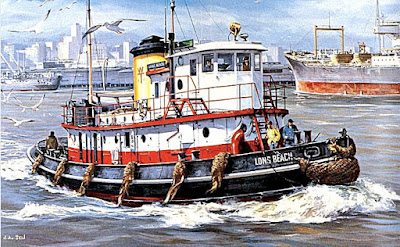
Steel's work included cars, airplanes, Navy ships, and a few commercial vessels, but the model companies discovered that customers weren't as enthusiastic about commercial ships.
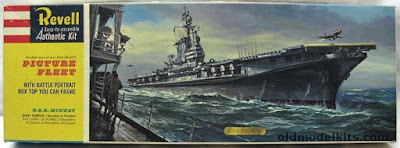
Steel led an adventurous life, serving in three wars, where he was wounded more than once. He also contributed in the field of combat photography and combat sketching.
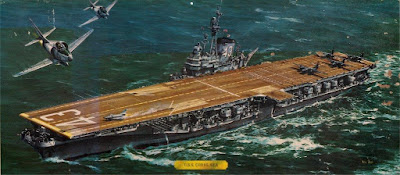
Along with Jack Leynnwood, who I profiled previously, Steel painted rapidly but accurately in gouache and casein.
He also was an accomplished hunter, fisherman, and scuba diver, painting many covers to Skin Diver Magazine.
Previously: Jack Leynnwood, Revell's Rembrandt
He captured the element of fantasy that let builders imagine what the actual vehicle might look like in an action setting.

Steel's work included cars, airplanes, Navy ships, and a few commercial vessels, but the model companies discovered that customers weren't as enthusiastic about commercial ships.

Steel led an adventurous life, serving in three wars, where he was wounded more than once. He also contributed in the field of combat photography and combat sketching.

Along with Jack Leynnwood, who I profiled previously, Steel painted rapidly but accurately in gouache and casein.
------
Website: John Steel ObituaryPreviously: Jack Leynnwood, Revell's Rembrandt
Thursday, February 20, 2020
The hub of the color wheel
Joshua asks on YouTube: "You said in part 1 of Color Wheel Masking, "... As each of these colors approaches the center, it becomes a neutral gray." Why neutral gray, what is the reasoning or significance for this? I see in some wheels, the use of (outer to inner circles) white, black and saturation centers as well as neutral gray. Same question regarding a center white or black, if you please?"
 |
| A color circle created using CMYK Sliders (Source) |
So the color wheel is a horizontal cross section of that 3D color volume, sliced through the peak saturations of each hue, with a gray at the center.
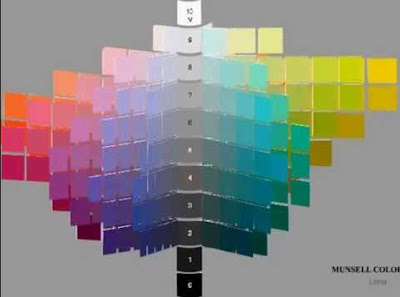
Most color wheels don't have a constant value all around the perimeter. I chose to represent the hues at whatever value shows them at peak chroma, and then I put the center point at an average gray value rather than raising it up to white or dropping it to black.
------
Labels:
Color and Light Book
Wednesday, February 19, 2020
Prohaska's Painting Method
"I will start today using the alla prima technique, and drawing with a brush. Right now, I'm going to prepare my palette.... I will use cerulean blue, ultramarine blue, raw umber, ivory black, naples yellow—if I have it—mars yellow, cadmium red light, cadmium yellow light, which I may or may not use. Now Grumbacher's titanium white—which is slow drying. And you will notice I squeeze out a great amount of color, particularly white. Turpentine is the only medium that I will use. Two cans of turpentine—one for painting, the other for washing the brush."
"Now there is one particular thing to notice, and that is this. That is how wonderful painting is, the wonder and magic of painting...that practically all of these dabs I'm putting on are in themselves kind of a mosaic pattern, completely abstract, right? You see them abstractly, but they build to a reality as they are held together, and being placed alongside each other is creating a kind of magic."-----
Read the rest in Illustration Magazine Issue 67, which also has features on Vincent DiFate and Samson Pollen.
Labels:
Golden Age Illustration
Tuesday, February 18, 2020
Extreme Expressions
This detail of a painting from Dinotopia: Journey to Chandara shows a singer in a millstone ruff.


Books:
Dinotopia: Journey to Chandara
The Artist's Complete Guide to Facial Expression
Emotions Revealed: Recognizing Faces and Feelings to Improve Communication and Emotional Life
 |
| Detail of Bilgewater Chorus, oil, |
In the photo reference I push the expression to the limit. It's not easy to hold an expression like this for very long, and it's rare to get a chance in art school to paint from a model with an extreme expression.
 |
| Photos courtesy Paul Ekman |
But faces are highly mobile and expressive, and if you stop-frame a video of people acting and reacting, their faces are constantly changing with brief expressions.
One of the pioneers of the study of expressions was Paul Ekman, who began his research in the 1950s, and introduced the concept of microexpressions.
----
Books:
Dinotopia: Journey to Chandara
The Artist's Complete Guide to Facial Expression
Emotions Revealed: Recognizing Faces and Feelings to Improve Communication and Emotional Life
Previous posts:
Monday, February 17, 2020
Online Trove of Natural History Images
 |
| From Tortoises, terrapins, and turtles, London, Paris, and Frankfort :H. Sotheran, J. Baer & co.,1872. |
------
Biodiversity Heritage Library on Flickr
Smithsonian Magazine: "You Can Now Download 150,000 Free Illustrations of the Natural World"
Labels:
Animals
Sunday, February 16, 2020
Fire and Ice Original to Be Auctioned March 1-2, 2020
On March 1-2, 2020, Heritage Auctions will offer an original background painting, complete with hand painted cel overlays, from the movie Fire and Ice (Ralph Bakshi / Frank Frazetta).
The description says: "Here's an exceptional original hand-painted cel and background setup from Fire and Ice, an epic high fantasy animated film that was a collaboration between Ralph Bakshi and one of the most important fantasy and science fiction artists of the past century, Frank Frazetta. It was also a collaboration with another artist of note, James Gurney. Mr. Gurney is best known for his illustrated book series Dinotopia; he painted the gorgeous backgrounds for Fire and Ice, his first major assignment. This splendid piece actually has two James Gurney paintings; the vine-wrapped tree at the right, and as an overlay, a foreground of flowers, a wall, and a pond. This scene occurs not long after Princess Teegra and and the warrior Larn first get together, at the ancient ruins; here, Teegra laughs as Larn clowns around after being told to "behave himself."2020 March 1-2 Sunday & Monday Comics, Animation, & Art Weekly Online Auction #122009
Saturday, February 15, 2020
King Piye Behind the Scenes
1. Kushite pharoah Piye (or Piankhi) traveled north from Nubia to conquer and unite the kings of the Nile, published National Geographic Magazine in November, 1990.
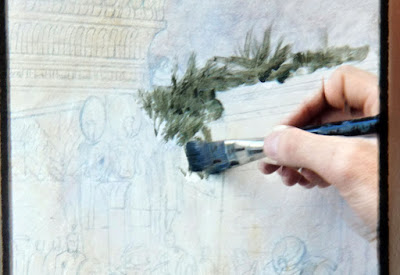
7. Beginning to block in the palm trees in the distance.
 This process is covered in greater detail in Step by Step Graphics Magazine, Volume 6 #7
This process is covered in greater detail in Step by Step Graphics Magazine, Volume 6 #7

7. Beginning to block in the palm trees in the distance.
- ----
A reader on Instagram asks: "When do you know you are happy with your underdrawing before you start painting.?I either keep making changes perpetually on the drawing, or get impatient and leave things out and start painting, adding elements as I go."
Answer: "I probably did 25 different preliminary sketches, most that I didn't show. Didn't spend more than a few hours on each sketch. Each one solves a different problem. Deadline keeps process moving forward."
Subscribe to:
Posts (Atom)

























